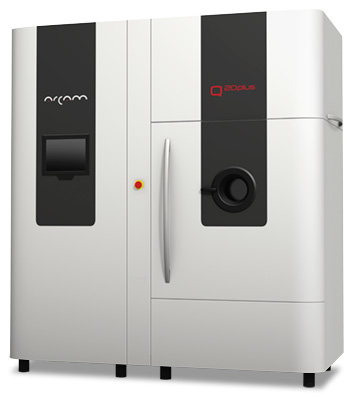Arcam Q20plus Offers Improved Productivity for Aerospace Components

The Arcam Q20plus has been developed specifically for aerospace production. Courtesy of Arcam.
Latest News
May 20, 2016
In the not-so-distant past, additive manufacturing (AM) was often viewed simply as a vehicle for rapid prototyping. The continuing evolution of the technology quickly changed that idea, particularly once metal printing processes hit the scene. In less than a decade, metal printing has gone from curiosity to an integral part of the aerospace industry.
Arcam is again targeting that specific industry with the launch of its new Arcam Q20plus. The new system is an update to the previous Arcam Q20 that was released in 2013. Both the old system and the new build parts using Arcam’s electron beam melting (EBM) process, which uses an electron beam to melt powdered metal at high temperatures inside a vacuum.
 The Arcam Q20plus has been developed specifically for aerospace production. Courtesy of Arcam.
The Arcam Q20plus has been developed specifically for aerospace production. Courtesy of Arcam.“With the Arcam Q series-plus we sharpen our offering to our main markets, the implant industry and the aerospace industry,” said Magnus René, CEO of Arcam. “With the introduction of the innovative Arcam xQam technology, Arcam reinforces its commitment being at the technological forefront within industrial additive manufacturing.”
As noted by René, the Arcam Q20plus offers new quality control measures, including Arcam LayerQam and Arcam xQam. LayerQam offers in-situ process monitoring and validation by monitoring each layer of a build, while Arcam xQam uses X-ray monitoring for auto-calibration and beam control. Arcam’s latest offering also comes loaded with updated software which, according to the company, aids the system to improve productivity by 15%.
Technical data for the Arcam Q20plus includes the following:
- build size: 350 x 380 mm
- beam power: 3000 W
- beam diameter” 140 μm
- size: approximately 2300 x 1300 x 2600 mm (W x D x H)
Below you’ll find a short video that presents objects built using Arcam’s EBM process.
Source: Arcam
Subscribe to our FREE magazine, FREE email newsletters or both!
Latest News
About the Author
John NewmanJohn Newman is a Digital Engineering contributor who focuses on 3D printing. Contact him via [email protected] and read his posts on Rapid Ready Technology.
Follow DE





